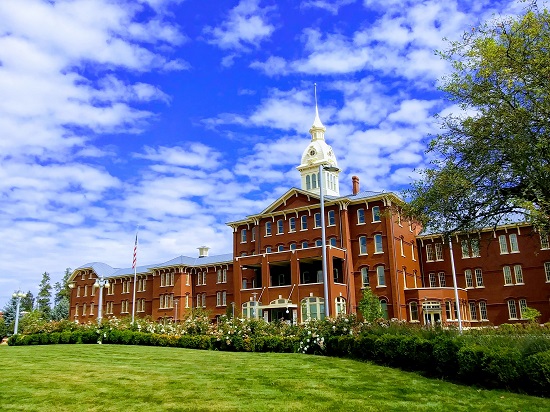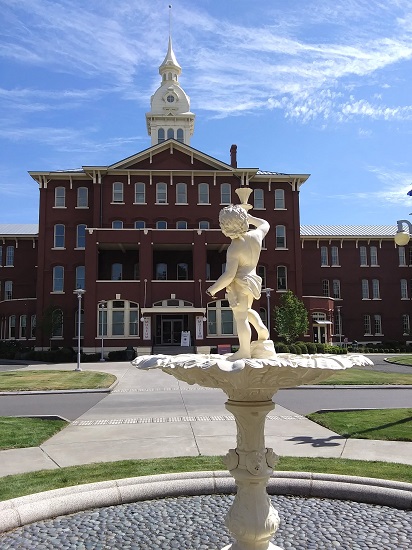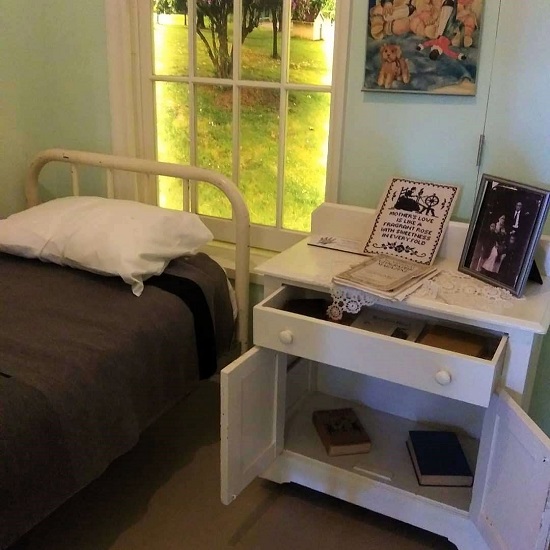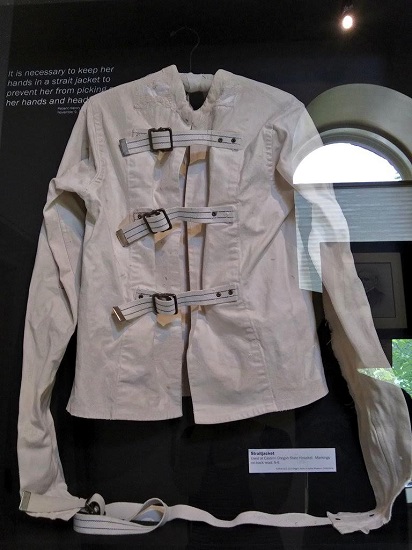Saturday, August 31, 2019, Salem, Oregon
In 2019, I took a Labor Day long-weekend trip to Salem, Oregon. Some of the trip was for chores (getting new tires!), but I also had time for some sightseeing.
The Oregon State Insane Asylum, now known as Oregon State Hospital in Salem, Oregon, has a long and fascinating history.

The Architecture
The hospital was built in 1883 as a Kirkbride Institution, and housed both men and women, and for part of its history, children. Kirkbride plan hospitals were known for their cutting-edge (at the time) ideas for treating the mentally ill, based on the belief that natural light and fresh air were critical for one’s well-being. Most Kirkbride facilities also gave jobs to patients who were physically and mentally able to work.
There were several different architectural designs, but the most common was the “bat-wing” style, where wings of the building stretched out from a large main portion of the building. There were 73 Kirkbride hospitals built; 33 Kirkbride institutions are still in existence in some form and on the National Register of Historic Places today. Oregon State Hospital has one of the only remaining original Kirkbride buildings. The building now houses the Museum of Mental Health, which is operated by a non-profit not associated with the hospital.

However, the grounds still house a psychiatric facility, which is not open to the public.
The Hospital
The hospital first began treating patients in Portland in 1862; the facility moved to Salem with the Kirkbride building construction in 1883, and is still operating today. The facility treated both men and women, and for a period of time also treated children. While the hospital did have some success in treating patients and returning them to their families, it was not without its controversies. As with all of the state mental institutions, it had periods where it was horribly overcrowded, with over 3,600 patients at one point.
The hospital practiced eugenics between 1923 and 1983, sterilizing over 2600 patients during the program’s history. Lobotomies were also performed there until 1981. In 1942, an accidental mass poisoning incident led to the deaths of 47 patients. Sodium flouride, a cockroach poison, was accidentally substituted for powdered milk in the scrambled eggs. It was tragic, and also sad that the kitchen had cockroaches in the first place, but probably not surprising.
When the hospital was at its peak, there were tunnels built underneath the buildings that allowed staff and supplies to move between buildings without going outside. This system of tunnels also allowed staff to move patients without having them be seen outside. Some of the tunnels even had a small narrow gauge railroad to move supplies! Most of these tunnels are no longer in use today, or are used as storage. I guess that gives you an idea of how big the property is. I only saw the main building, but there are dozens of buildings on the site, and it is much smaller now than it was in its heyday.
One Flew Over the Cuckoo’s Nest
It will probably surprise you to hear, but the movie One Flew Over the Cuckoo’s Nest was filmed here in 1975. The cast was permitted to watch patients in their daily routine and even observe electroshock therapy treatments as a part of their rehearsals and to get into character. The movie depicts some actual hospital patients and staff, who were used as characters and extras during the film. Dr. Dean Brooks, the hospital’s superintendent at the time, plays a role as Dr. Spivey, the main character’s doctor. When Dr. Brooks complained that the screenplay was unrealistic, he was told to rewrite his dialogue to make it medically accurate. The film won several Academy Awards for its depiction of the mental health system and life in an asylum.
The Museum of Mental Health
Today, the main Kirkbride building at Oregon State Hospital has been opened as a museum. The museum examines the history of the asylum system, and details what life was like in the hospital. There are exhibits with medical equipment, ones that show a patient room setup, and others that explain leisure activities that were offered at the hospital. There is even an exhibit about the filming of One Flew Over the Cuckoo’s Nest. The museum is one of the only areas of the grounds where the public is allowed today, and it was a very interesting visit!


The Dead
In 2004, Peter Courtney, an Oregon State Senator, toured the hospital and learned that over 5,000 sets of cremains were being stored in canisters in the basement of the original building. These were the cremated remains of patients who were never claimed by their families. The canisters were in poor condition, corroding due to the moisture in the basement (a common issue in the Pacific Northwest).
The Oregonian newspaper did an investigatory article, and the hospital received a lot of criticism about their treatment of these poor souls. As a result, the state allowed the hospitals to release the names of the patients, in hopes that some of the families might finally retrieve them. Those who remained unclaimed were interred in a wall on the grounds, and a nearby building was redesigned as a memorial to those who died here. The canisters they were originally stored in are displayed. In my photograph, I tried to make them something beautiful!

Overall, it was an interesting and enlightening tour. It raises a lot of questions about how we have treated the mentally ill in the past, and how we treat them today. Although the asylum system certainly had its faults and there were bad apples among the staff, as well as mistakes made with treatment protocols, are we really doing any better now? We have moved from the asylum system to a system where many of our most mentally ill citizens are either in prisons or homeless. Can we really say we are doing better?


















